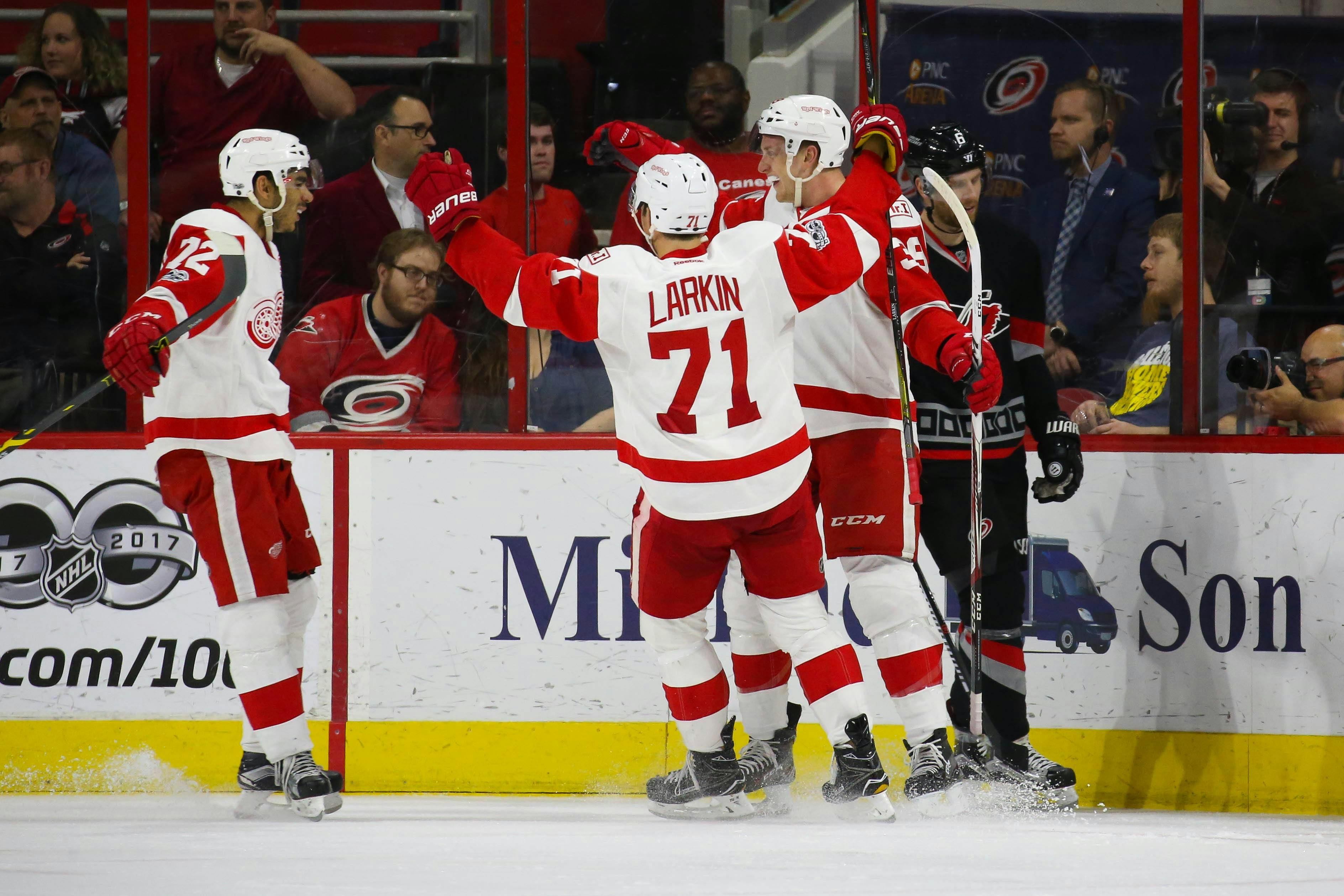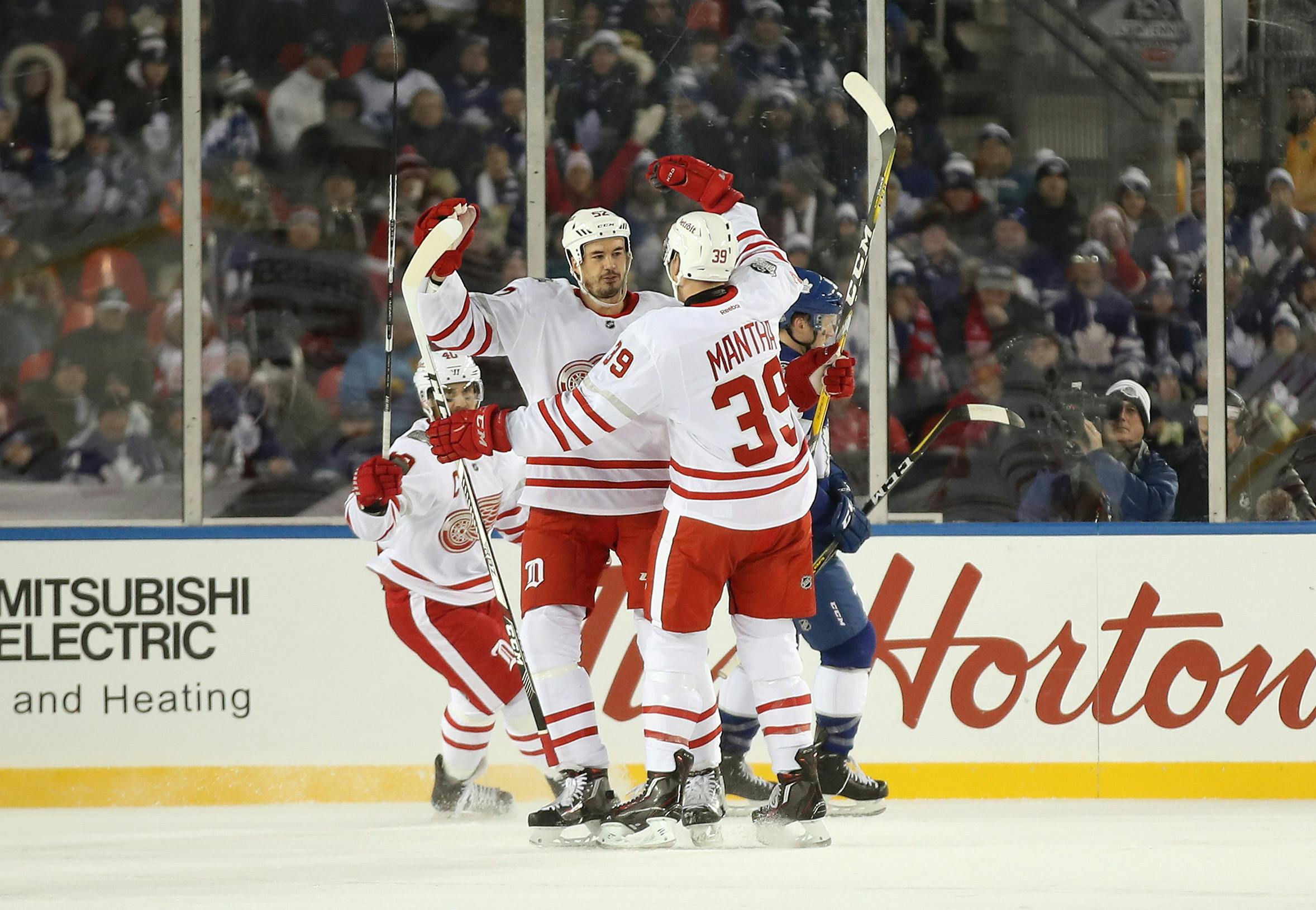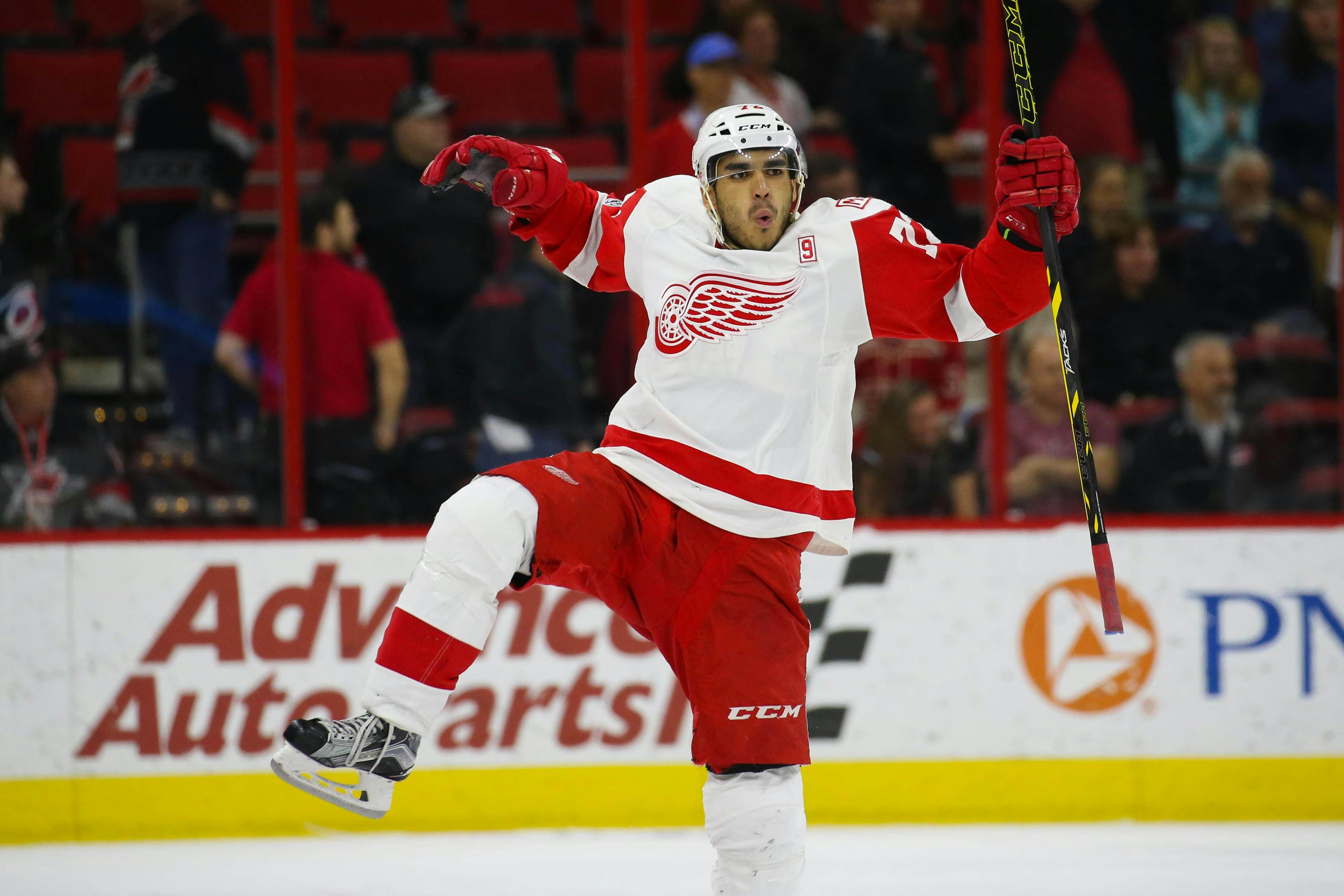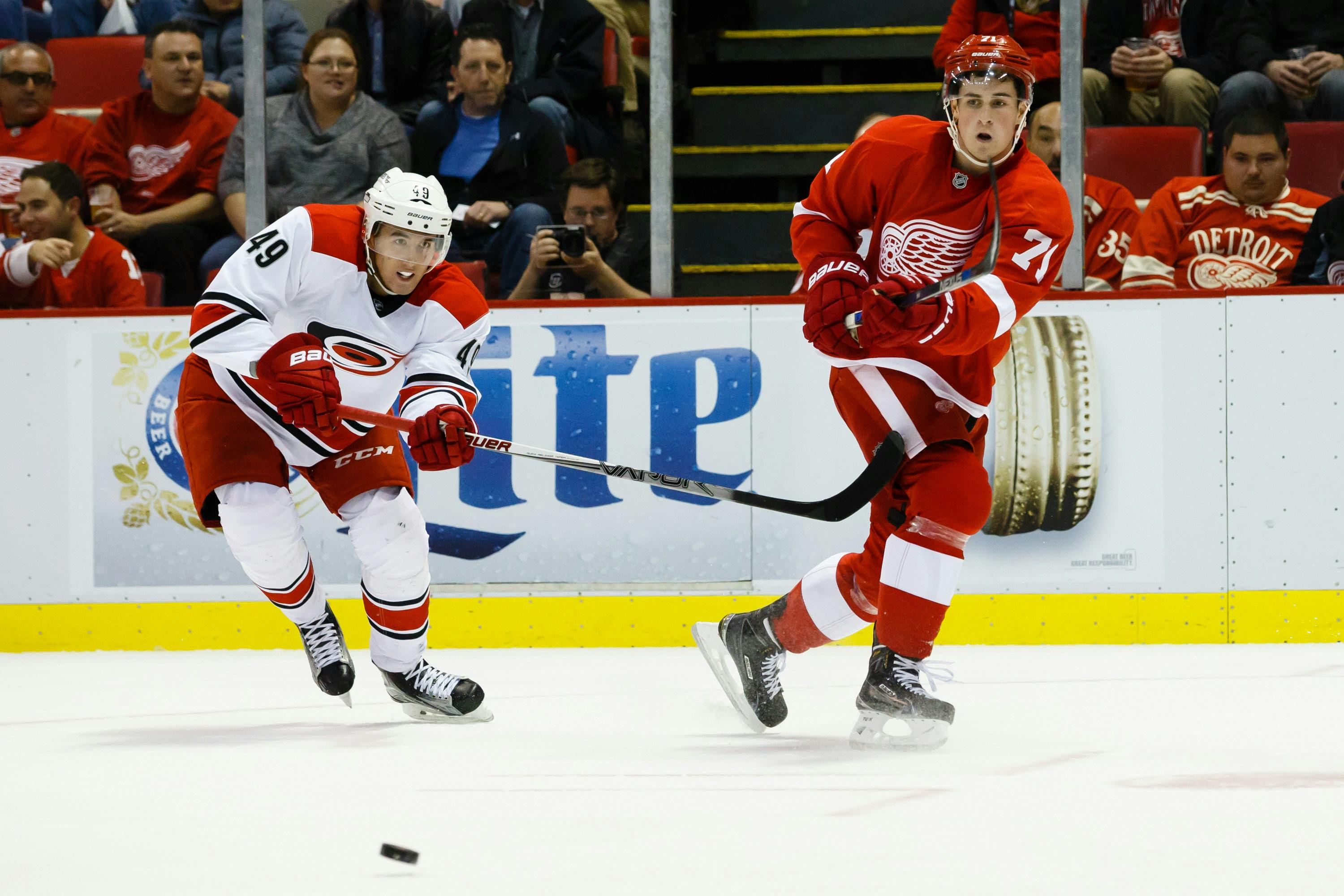How far away are the Red Wings from having a “big 3?”

The Detroit Red Wings’ forward group is an interesting mix. In a team that should be looking to get younger and younger, its top five point getters this season all were age 26 or older. As most players tend to peak in their age 24-28 seasons, it shows that the Red Wings are in dire need of a) moving these players out or b) getting more production out of their younger players if they hope to return to icing a competitive hockey team.

Before we discuss the team’s youth movement, let’s look at the players who make up the Wings’ top 5 forwards from 2016-17:
- Thomas Vanek obviously left at the trade deadline, putting up 38 points in his 48 games in the Detroit uniform.
- Tomas Tatar and Gustav Nyquist are two players who can be described by just about anybody who watches them as frustrating. You just KNOW there’s another gear there…
- Frans Nielsen put up 41 points in his first year of a six-year deal with a no-movement clause. That’s solid second line production, but he’s also 33. Take that as you will.
- And sadly, just about anything Henrik Zetterberg does at this point is just padding his point totals for his career. Even if he keeps up his production next season, it’s unlikely he’ll still be putting up over 65 points for the Red Wings at the same time as a playoff year.
From Zetterberg to Tatar there was a 20-point drop-off from 68 points to 48 points, as for the second consecutive year “Z” was the only player to put up 50 points in a Red Wings uniform.
Age obviously doesn’t matter when it comes to who’s producing points for a hockey team on the scoresheet, but it does matter quite a bit to roster composition and a franchise’s future prospects. If you’re winning the Stanley Cup with a bunch of 35+ guys, so be it, but when you’re missing the playoffs, the pill is that much harder to swallow that your team is full of aging veterans. As the league’s 5th oldest team at the end of the season, the Red Wings are in dire need to get younger. Luckily, they’ve got a decent trio of young guys to turn to for the now, and for the future.
The Kids
Sparking a bit of hope for the future of the franchise is three players currently on the roster. Maybe we’ll add Evgeny Svechnikov to that group a year from now, but for today we’ll stick with discussing a trio of second-year forwards.
It’s no surprise who these three players are: Anthony Mantha, Andreas Athanasiou, and Dylan Larkin.
While all of these players have considerable upside, none of them had what you could call a spectacular offensive season. Mantha was the top scorer of the three topping out at just 36 points.
Let’s compare league wide to the 49-point mark, which is what Mantha projected out to if he played all 82 games.
31 players 23 or under hit the 49 mark this past season. There were three each on Calgary, Toronto, and Winnipeg, while 15 teams had at least one player on that list. Eight other teams who were not on the list with at least one 49-point scorer 23 or under still made the playoffs this past year.
In total, there were 108 players who put up at least 49 points this season- averaging out to about 3.5 per team. The Wings had 1, but in all honesty had he stayed healthy and with the team, Thomas Vanek would’ve been on that list as well. In terms of young offensive cores, the Wings are getting beat by many other teams in the league right now. Let’s look one-by-one at the Wings three pieces, and how their futre shapes up.
Anthony Mantha

Credit: Tom Szczerbowski-USA TODAY Sports
Pure point totals: 60 GP, 17 goals, 19 assists, 36 points.
In his first “full season”, Mantha had a respectable season, but was heavily overshadowed by an incredible rookie class. Coming into the league at age 22 isn’t nearly as impressive as putting up these numbers at age 22, he compares to perhaps Brayden Point from this year’s class as well, who put up 40 points in 68 games, or Robby Fabbri, who put up 37 points in 72 games the year prior in St. Louis.
Prorated stats over 82 games: 24 goals, 25 assists, 49 points.
As the Wings’ top player from this contingent this past year, Mantha looks like a lock to hit the 20-goal mark for the first time in his career next season if he sticks around for all 82 games. If he doesn’t manage to have a consistent roster spot, get your pitchforks ready.
Mantha put up 107 goals over his final two years of junior hockey in 124 games, so his scoring touch is definitely something that Wings fans have been looking forward to and expect. While he probably won’t be dropping 40-goal seasons any time soon, if Mantha can push himself to be a
5v5 stats: 15 goals, 4 primary assists, 2.18 P/60.
Mantha sat 9th on the team in power play time, and 7th among forwards. He racked up a whole whack of goals at even strength and put up a great P/60 that ranked 33rd in the league of regular players.
Role: As we’ll be using to evaluate the other two as well, this old article from Habs EOTP lays out what kind of production to expect from different levels of roster players. Mantha fits in at the latter half of a top-line role. This is currently the top out of the three youngin’s… an average first liner.
Other positives: We haven’t even seen a full season out of Mantha yet. There’s still more to come, surely.
Other negatives: Mantha’s always been known as a goal scorer primarily, but the guy needs to add some diversity to his game to be considered as a premier player in this league. Mantha also had some strange rifts, though no fault of his own, with the team’s management and coaching staff. So we’ll see how that goes.
Andreas Athanasiou

Credit: James Guillory-USA TODAY Sports
If nothing else, Andreas Athanasiou is a human highlight reel when he’s on his game. There’s a soccer player who you may recall from these goals at the 2014 World Cup by the name of James Rodriguez. With his current team of Real Madrid, Rodriguez has put up 24 goals in 72 games, which isn’t otherworldly by any means, but very solid production. However, there’s a saying that “James only scores golazos”, because it seems like every time he scores a goal, it’s the kind of marker that you’ll be telling your grandchildren about. The same could easily be applied to Andreas Athanasiou. Whether it’s on a breakaway or simply on a slick offensive zone move, this is not a guy who scores tap-ins very often.
Pure point totals: 64 GP, 18 goals, 11 assists, 29 points.
On a season where he was fighting to crack the roster (for literally no good reason), Athanasiou finished second on the team in goal scoring. Granted, that’s on a team who finished 24th in the league in scoring, but Athanasiou still finished 73rd in the league in goals-per-game.
Prorated stats over 82 games: 37 points, 23 goals, 14 assists.
Athanasiou’s prorated stats won’t blow you away, but it’s important to remember that he also frequently got the short end of the stick when it comes to ice time. 23 goals is a very respectable amount, but Athanasiou has to become a better puck distributor if he wants to step his game up to the next level.
5v5 stats: 15 G, 5 primary assists, 1.95 P/60.
In 2015-16, Athanasiou was putting up better production than almost everyone else in the league at 5v5. In 37 games, he was 10th in the league of players who put up at least 300 minutes at 5v5. This past year, his numbers evened out a little bit, as he fell to 66th.
On the powerplay, Athanasiou was used sparingly, as the team’s 9th most frequent forward and 11th most frequent player overall. You’d think those numbers would spark up next season, but every day with Blashill is a rollercoaster.
Role: While AA dabbled briefly as a centre, he’s played the vast majority of his minutes as a winger. On the EOTP scale, prorated to 82 games, he slots in as an average second-line winger.
Other positives: Whatever the Wings get from Athanasiou is really just bonus. If you can ever turn a 4th round pick into a top-six forward (or even just a regular NHL player), you’ll take that any day of the week.
Athanasiou also spent 100 minutes with Riley Sheahan this year, nearly 1/7th of his ice time. Unsurprisingly, he managed just 1 goal in that timeframe and ZERO assists (wonder why?). When he’s away from him, AA’s production shoots up significantly.
Other negatives: It’s not really a knock against him, but for whatever reason, like Mantha, he’s struggled to find a consistent spot in the lineup. Whether playing in the team’s bottom six or not playing at all, Athanasiou and Jeff Blashill haven’t always seen eye-to-eye.
15 of his 99 shots at 5v5 went in, which lines up well with his 15% shooting percentage at all strengths. We don’t have a large enough career . 8.7% sits as the league average for this past season. Is he an above average shooter? Probably. Will he be able to keep up a 15% mark? Over the last three seasons, just three players who have played at least 100 games have been able to do so. It’s definitely possible, but it will be a major factor in if he’s able to keep up his production. It’s not necessarily a negative, but it definitely could come up as a red flag if he starts to slump.
Dylan Larkin

Credit: Rick Osentoski-USA TODAY Sports
Pure point totals: 80 GP, 17 goals, 15 assists, 32 points.
Larkin took a step back after an impressive rookie campaign when he was named to the All-Star game and put up 45 points. It’s hard to say this wasn’t a disappointing year from him. Larkin started off with just one point through six games, and had just ONE assist through October and November (though he did have eight goals). From January 18th to March 4th, Larkin picked up just a single point. No, there was no Olympic break in there, but there was 15 games. Larkin had just four multi-point games, compared to 2015-16 where he had seven.
Prorated stats over 82 games: Yeah I’m not going to do this one. Maybe one missed night could’ve led to a 8-point effort to put him at 40?
5v5 stats: 9 goals, 6 primary assists, 1.20 P/60. Out of the three players, he was the least effective at even strength as he picked up a large portion of his points on the power play. In 2015-16, his primary stats were exactly double this, as he had 18 even strength goals and 12 primary assists.
Role: Larkin played both centre and wing this season, but would fit in as either a third-line centre or a second-line winger according to the EOTP scale. Probably somewhere in the middle.
Other positives: This kid is young. If he wanted to, he’d be heading into his fourth year at Michigan this fall. Would it really be an issue if the Wings had kept him in college if he was any other player? He’s still got tons of room to grow, and is the first Red Wings player in a long time to complete two seasons before his 21st birthday.
There’s a joke that Larkin’s negatives don’t matter because he can skate really fast, but he’s not losing the speed anytime soon. Few players not named Connor McDavid can catch up to him when he really gets going.
Other negatives: There’s been a narrative around Larkin that he’s become a one-trick pony. I’m not sure how true that is, but next season will be a key one in assessing what type of player exactly Larkin will pan out to be.
Larkin took 43 less shots this year than his rookie year in the same amount of games, while only seeing his shooting percentage drop by 0.8%. He wasn’t exactly snakebitten. His on-ice shots/60 rate went down from 30.2 in 2015-16 to 27.5 this past year, meaning he was less effective at getting his teammates to put pucks on net. Unsurprisingly, he only had six primary assists at even strength this year.
In conclusion, the Wings still need much, much more out of their young guns before they’re on par with being consistent top-line performers. This isn’t a knock on them necessarily: Mantha was selected 20th overall, Larkin 15th, and Athanasiou 110th. None of those spots project out to be “franchise” player levels, so there’s nothing wrong with their careers if they all peak at a top-six level.
But while they didn’t have much trouble putting the puck in the net themselves, the Red Wings got 15 primary assists at 5v5 combined through the three young players in 2016-17. If they were one player combined, they’d be as good a playmaker as Nick Schmaltz or Jason Zucker, who both tied for 29th in the league in that category. (So did Mike Hoffman and Alex Ovechkin, but those names are less fun and more well-known).
Of course, it’s possible to point out that these players have played just two years in the league, and give them a chance. But at the time when other teams are being dominated by players younger and younger, it’s important to know that if the Wings sit around satisfied with what they have the Maple Leafs and Jets of the league will quickly overtake them (in some instances, they already have.)
Evgeny Svechnikov is the most likely candidate to make the talented trio into a fancy four, but so far, none of this foursome projects to be a superstar, elite level producer. It’s still young in their respective pro hockey careers yet, but if the Red Wings are going to be reliant on this group of three attacking players moving forward, don’t expect any ticker-tape parades in Hockeytown anytime soon.
Recent articles from Adam Laskaris





